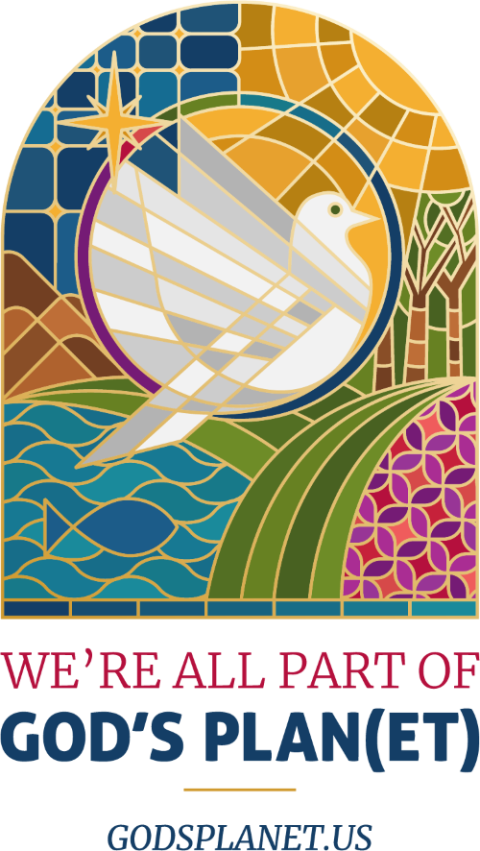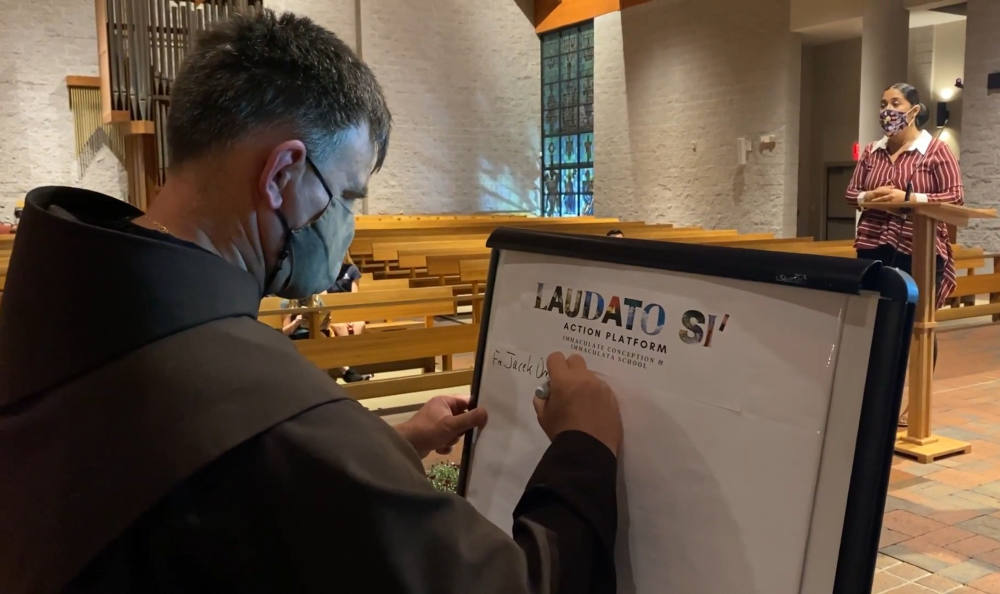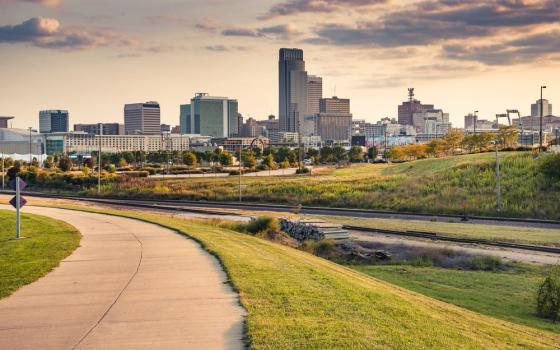Students at St. Francis International School in Silver Spring, Md., tend the lettuce and other greens in the school garden as a part of their environmental science curriculum in this 2018 file photo. The Archdiocese of Washington issued an action plan Aug. 16, 2021, based on Pope Francis' 2015 encyclical on caring for creation, "Laudato Si'." (CNS/Catholic Standard/Jaclyn Lippelmann)
When it was announced last year, Katie Hirschboeck and members of the creation care team at Our Mother of Sorrows Church, in Tucson, Arizona, immediately knew they wanted to get involved with the Laudato Si' Action Platform, the Vatican's major effort to move the global church toward sustainability in the spirit of Pope Francis' 2015 encyclical on ecology.
Enrollment in the program officially opened Nov. 14, 2021, about three years after it was conceived within the Dicastery for Promoting Integral Human Development. As Hirschboeck, a retired climate scientist at the University of Arizona, examined the platform website, she felt overwhelmed: partly by its design and message — "I nearly had tears in my eyes because it was so hopeful" — but also by the magnitude of the project — a seven-year initiative in which households or institutions across seven sectors of the church seek to complete a series of actions associated with seven overarching goals around sustainability, simple living and ecological spirituality.
With parish meetings limited due to the COVID-19 pandemic, the Our Mother of Sorrows creation care team members elected to each first enroll under the individuals sector. This would give them a chance to build momentum at the family level before taking on the platform as a parishwide community.
"It's not been easy to ramp up. But I have great hopes for it," Hirschboeck said.
Five months after enrollment opened, the Laudato Si' Action Platform and its organizers remain focused on building that bottom-up momentum to deliver a Catholic contribution to efforts to combat climate change, reverse biodiversity loss and take on other environmental challenges facing the planet.
The ambitious global church project remains a work in progress as scientific reports increasingly ring the bell for more rapid action on climate change.
Waiting for 'the big waves'
The rollout of the Laudato Si' Action Platform has not been without its challenges or delays. Most recently, the enrollment deadline for the first Laudato Si' cohort was pushed back from Earth Day (April 22) to Oct. 4, the feast of St. Francis of Assisi and the close of the Season of Creation.
The integral human development dicastery now plans for a regular enrollment schedule where each year new sign-ups open on Nov. 14, the World Day of the Poor, and close on Oct. 4, with a 40-day prayer campaign then preceding the start of the next enrollment period.
Organizers say the new schedule provides more time for people to familiarize themselves with the platform, especially as COVID-19 and economic challenges have dominated attention for many parishes and schools for the past two years, as have global events like the ongoing war in Ukraine and other conflicts.
"We realized that people are still getting to know the action platform," said Salesian Fr. Joshtrom Kureethadam, coordinator of the dicastery's ecology sector.
The extended enrollment period also allows for more promotion of the platform during creation-centric times on the church calendar. This May, the now-annual Laudato Si' Week will spotlight the action platform, with each day focusing on one of its seven Laudato Si' goals. And the Season of Creation (Sept. 1–Oct. 4) will also be a time to raise awareness, Kureethadam said.
"We think the big waves have not come in yet," he told EarthBeat.
Solar panels are seen on the roof of the Paul VI audience hall at the Vatican in this Dec. 1, 2010, file photo. Under Pope Benedict XVI, Vatican City began installing solar panels in 2008. (CNS/Paul Haring)
At the time enrollment opened, roughly 4,200 institutions and families had preregistered. In the five months since, the tally has grown marginally, up to 4,579 as of the end of March, according to statistics the dicastery shared with working groups.
Organizers say that growth rate isn't surprising, with some pleased with the progress, and attributing it to a combination of factors, including technical issues with the registration process. A reassessment by the dicastery started early in the year to address those and other concerns. In addition, preregistrants did not automatically get enrolled; they had to go through the full process once the window opened in November.
Of those enrolled, nearly 2,700 are institutions, compared to about 1,900 individuals or families. The largest share among institutional sectors are religious orders and congregations. Forty-five percent of enrollees to date are from English-speaking countries. Geographically, about 40% of enrollments have come from Europe, with nearly 27% from North America.
The Vatican has celebrated the fact that the largest women and men's religious orders, the Salesian Sisters and Jesuits, have committed to the platform, with expectations that their communities and institutions will help build momentum.

Franciscan Sr. Sheila Kinsey speaks during a March 18 webinar updating religious orders and congregations about the Vatican' Laudato Si' Action Platform. (NCR screenshot)
During a March 18 webinar, the heads of the global umbrella leadership groups for men and women religious each delivered messages of support and "strong commitment" at all levels to the Laudato Si' Action Platform. Loreto Sr. Patricia Murray, executive secretary of the International Union of Superiors General, said that some actions will be big and bold, but the majority will be smaller efforts, which can make an impact as "small seeds that we're planting to bring about transformation."
"It's fair to say that both as sisters and brothers, we have moved quickly to respond to Pope Francis' appeal," Murray said.
Within the U.S., notable early enrollees include CommonSpirit Health, one of the nation's largest health care systems, with 140 hospitals and 1,000-plus care sites in 21 states. More than 40 Catholic colleges and universities have also joined, including Catholic University of America, Georgetown University, Loras College (Iowa), St. Mary's College (South Bend, Indiana), Santa Clara University and the University of St. Thomas (Minnesota).
In addition, the archdioceses of Atlanta and Indianapolis, the dioceses of Davenport, Iowa; Worcester, Massachusetts; and Arlington, Virginia, are among those officially enrolled. The archdioceses of Washington, D.C., and Chicago and the San Diego Diocese have each made Laudato Si' action plans and are expected to enroll at some point.
In Durham, North Carolina, Immaculate Conception Parish eagerly joined the Laudato Si' Action Platform in December.
"I see the benefit of doing it [in] making the Laudato Si' encyclical more operative and translating into action with benchmarks. And to do it not just as an individual parish but with other faith communities," said Franciscan Fr. Jacek Orzechowski, Immaculate Conception pastor.
While the parish continues to complete the in-depth registration process, it is moving forward with a slew of initiatives that will feed into the platform's goals, including installing solar panels and hosting a discussion next week on the connections between the crisis in Ukraine and climate change.
But a full accounting of all enrollees has not yet been made available, even to national hub organizations like the U.S.-based Catholic Climate Covenant. So far, it's learned of participants either through direct contact or from members and partners who sit on the platform's various working groups. A partial list of participants is featured on its We're All Part of God’s Plan(et) website that is promoting the platform.

Logo for Catholic Climate Covenant's We're All Part of God's Plan(et) campaign (Courtesy of Catholic Climate Covenant)
Not knowing who is participating makes it difficult to coordinate and assist those U.S. institutions, said Paz Artaza-Regan, the Catholic Climate Covenant's point person for the action platform and a member of the parishes and dioceses working group.
"We are working in a little bit of a fog," she told EarthBeat.
Orzechowski added that knowing who else is undertaking the platform journey will allow networking, sharing ideas and resources and collaborating on projects, such as lobbying local elected officials, where a louder voice can be more impactful.
The dicastery says it has heard the requests for more transparency about participation, but concerns about privacy laws in Europe have prevented it from divulging exactly who's taking part in the platform. A full map of enrollees is in the works, but a timeframe for when it will be released has not been determined.
Forming a 'bottom-up groundswell'
Communication was one issue that arose from the evaluation process the dicastery undertook with its working groups for the seven sectors earlier this year.
Reasons are varied. A small staff of less than 10 people is working on the project within the dicastery, which itself is going through a transition as Cardinal Peter Turkson left his post in December and Cardinal Michael Czerny is leading in an interim role. Four months earlier, Salesian Sr. Alessandra Smerilli was named interim secretary as the dicastery's No. 2 official.
But perhaps the biggest source of challenges has been the magnitude of the project itself, coordinating a multiyear, multipronged initiative across dozens of countries, a multitude of cultures, numerous languages and varying levels of technology, skills and communications. Such a massive project may normally take several years of planning, and the bulk of the action platform's development and rollout has occurred in the midst of a pandemic, all while the urgency presented by climate change — with scientists identifying this decade as critical for action to avoid the most severe consequences — has called for ever-swifter responses.
On the technical side, the registration portal had issues. To complete enrollment, people first had to fill out a lengthy self-assessment that required gathering information related to their home's energy use, water use and ethical standards associated with insurance and investment firms. The system would not allow people to save their work and come back.

Diana Harper displays her environmental and Laudato Si'-inspired denim jacket during a bilingual Earth Day event in April 2018 at Our Mother of Sorrows Parish, in Tucson, Arizona. (Courtesy of Our Mother of Sorrows Parish)
Those bugs have been fixed, and the self-assessment is now optional and accessible after enrollees familiarize themselves with the platform. Uploading a reflection and personalized action plan are still required. Institutions can now opt to have their names shared. Enrollment videos, FAQ sections and other tutorials have also been added to the website.
"As we are getting the feedback from folks in dioceses and parishes, families, we're able to tell the dicastery this and they're listening and pivoting and changing and creating resources to assist," Artaza-Regan said.
The Covenant, through its We're All Part of God's Plan(et) campaign, also has created a number of resources for navigating the enrollment process, including a video about the various websites and tools. A separate website, LaudatoSiuniversities.com, has information for higher ed institutions, and the religious communities have created their own tools and walk-throughs on their Sowing Hope for the Planet site.
The dicastery has added staff to work on the platform, which it oversees with the Laudato Si' Movement. It has also set up seven regional steering boards in an effort to bring the platform to a more local level. In many cases, the boards are organized through ecclesial networks the Vatican has helped establish in recent years, such as REPAM in South America, REBAC in Africa, the River Above Asia and Oceania Ecclesial Network in Asia and Oceania.
In the U.S., the Catholic Climate Covenant is working with Yakima, Washington, Bishop Joseph Tyson, its ecclesial liaison, to connect with bishops in Mexico and Canada.
In addition, national assemblies on the Laudato Si' Action Platform — involving dioceses, religious orders, schools and representatives from each sector — are also in the works. One is planned for Italy, and others have already taken place in Europe and Asia. The Covenant hopes that details for a U.S. gathering will be determined later this year.
Beyond highlighting creation-themed moments on the calendar, the dicastery has reached out to church leaders directly. During the 2021 Season of Creation, Turkson sent letters to each bishop and religious leader around the world inviting them to join the platform. Members of the dicastery have also spoken with bishops during ad limina visits to the Vatican and with religious communities during chapter meetings in Rome.
Kureethadam said their goal is for the platform not to become a decree from above or a bureaucratic body, but a bottom-up groundswell where local communities become the main protagonists of the platform.
"Salvation always comes from below," he said. "Real changes will come from bottom up, will come from our communities, from ordinary people. But then when we come together … we can create a critical mass for change."
Advertisement
It's that same mentality for building momentum that led Our Mother of Sorrows in Tucson to enter into the platform through its families before building up to the full parish.
Hirschboeck said they have noticed improvements with the platform as individuals have worked to finish their enrollment. She added that having the extra time, especially during Ordinary time on the liturgical calendar, will allow them to better plan and prepare their next steps.
Artaza-Regan said she thinks that approach can be effective for many parishes and institutions across the country, where there might not yet be the interest or ability to develop a full organizational action plan. She has heard from people who are interested in the platform, but maybe not as part of the first cohort, preferring instead to see how the early adopters do.
"Nobody ever wants to be in the first rows of the church, you know that," she said.









